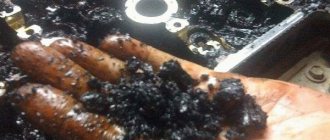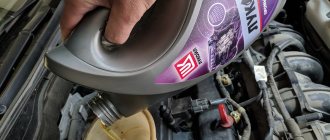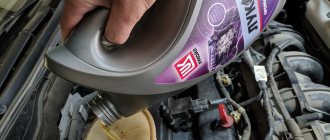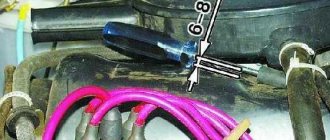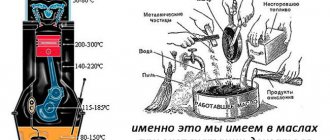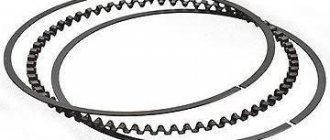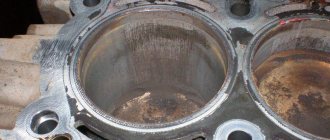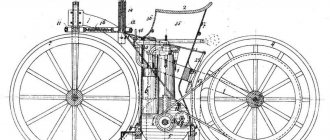The life of a car cannot be compared with a human one. Simple arithmetic: at idle, a diesel engine makes a minimum of 600 revolutions per minute - that is, 10 per second. In this case, the piston “walks” 20 times. We press on the gas - the number of revolutions exceeds a thousand. Add here the constant exposure to high temperatures or cold when starting in winter... A person could never even dream of such an extreme! Therefore, forgetting about such a procedure as engine decarbonization using LAVR ML202 or ML203 NOVATOR is a real crime.
The need for decarbonization
In most cases, decarbonization makes it possible not to bring the engine to major reconstruction. Drivers of vehicles with high mileage face the problem of carbon deposits on the engine when operating a car.
Also, the condition of this important vehicle system is significantly influenced by the quality of fuel and lubricants used. Therefore, you should not save money when choosing fuel and oils for refueling your car: otherwise, expensive repair work will be inevitable.
Decoking of piston rings without disassembling the engine involves cleaning their grooves from carbon deposits. Such work to remove coke is carried out in four ways (three of them are carried out without opening the engine and, in fact, are purely preventive measures). All decarbonization methods differ in:
- labor intensity;
- effectiveness;
- price component.
The fact that your car’s engine needs decarbonization can be determined by the following signs in its operation:
- having problems starting the engine;
- significant increase in fuel consumption;
- the appearance of dense black or bluish smoke;
- reduction in engine power.
The main reason for the accumulation of carbon deposits on the valves and in the fuel chamber is prolonged operation of the engine at low speeds, as well as frequent and long periods of standing in city traffic jams. Traveling with an insufficiently warmed up engine or using poor quality fuel or motor oil can lead to a similar result.
The occurrence of soot is also affected by incomplete combustion of the combustible mixture. The situation worsens when exposed to carbonaceous particles from exhaust emissions. Carbon accumulation also occurs due to coking of the engine.
One of the above signs is enough for a car repair shop to offer you a major overhaul of the engine. But this is complex and very expensive work.
It is usually recommended to carry out decarbonization work in the spring or autumn to prepare the vehicle for the change of season. Previously, car owners usually did this work themselves. Today, owners of modern cars often prefer to use the services of car service specialists. This is most likely due to the fact that new engine models have appeared, for which getting to the spark plugs or injectors is not an easy task. Still, decarbonizing the engine yourself is not ruled out.
Decarbonization of rings and car engine pistons
Decoking of the engine and piston rings is a process in which carbon deposits are removed from the parts of the cylinder-piston group. Carbon deposits are formed due to the combustion of low-quality fuel and motor oil on pistons, their rings and valves. Due to carbon deposits, rings often become coked and stuck, so it is necessary to decoke the rings and pistons.
Carbon deposits can also be removed at home using special chemicals:
In total, there are 4 ways to decarbonize an engine, three of them without disassembling the engine and relate to the prevention of internal combustion engines.
Interesting facts about decarbonization
Since the times of the USSR, the quality of gasoline has improved, but the problem remains - any driver is faced with the removal of slag and coke on the piston rings. Soviet oil is also far from modern, but not a single car owner can fully claim that it does not form carbon deposits. Persistent deposits that affect the stable operation of the cylinders will lead to a major overhaul.
Main misconceptions:
- The first incorrect conclusion is that modern engines do not need decarbonization. Any engine is operated in harsh conditions, including winter. This is the first and main reason for the formation of carbon deposits. Modern piston systems have provided parts with smaller clearances and grooves, which increases vulnerability.
- Decoking of XADO, LAVR and other similar decoking agents cannot be called the only method of “treating” an engine. Periodic cleaning with oil changes will give good results, but the products are only good for standard engines. Namely, with a volume of no more than 2 liters, a vertical arrangement of the cylinders, and a shallow recess in the piston bottom. Otherwise, it must be filled with the product separately.
- High cost is a reckless statement from an inexperienced driver. Anticoke costs much less than a major overhaul. For example, decoking laurel, the instructions for use of which are simple and clear, are made in Russia, which means the price is several times lower than imported analogues. According to research results, it ranks second in the Russian market, the soaking time of soaked pistons is 8-10 hours.
- Engine decarbonization fluid works the same for all types of engines. There is no need to look for compounds separately for diesel and gasoline engines. The repair and maintenance operation is performed in a standard manner. Avoid working in winter, outdoors or in the rain.
- Decarbonization of oil scraper rings is impossible with a cold engine. A heated engine provokes a steam bath, softening the carbon deposits. Otherwise, the deposits will not soften, and the effect of the procedure will be zero.
- Using anti-coke is not the only cleaning method. Some car models have a complex design, it is impossible to get close to the technological holes of the cylinders; you will need a set of special tools. The volume of liquid added should not exceed the manufacturer's recommendations.
- Additives for decoking oil rings will not clean carbon deposits white. From a technical point of view, this makes no sense. A composition that is too caustic will cause damage to parts.
After cleaning, the car will smoke, but not always heavily. In addition to slag and other carbon deposits, the system will emit anti-coke residues. If you remove the liquid remaining on the cylinders, there will be much less smoke.
You might be interested in this article -
For convenient introduction of the composition into the holes, some manufacturers add a special syringe to the kit.
Of the products that do not require removing candles, the most popular is Edial decarbonization. The advantages are that they work exclusively in the combustion chamber, activation at elevated temperatures, and cleaning in normal mode.
Mixing is simple - just pour the drug into the fuel tank at the gas station before refueling. The priorities are decoking of the diesel engine, including mineral residues (ash), which are formed at a temperature of 850 degrees.
How to decarbonize a diesel engine?
Academically, there are three ways to remove any solid deposits:
Direct impact method
This could be a simple scraping or stripping. Nobody canceled the sandblasting machine. However, these methods have serious drawbacks.
This does not mean that the method is off the agenda. Mechanical processing is used, but it is better to do it in bench conditions, with control of geometric parameters.
Mechanical method with ultrasound
This method is relatively safe for the parts being cleaned. Only the slag deposit crumbles, the geometry is not violated, and the gaps do not become larger. However, installations for generating ultrasound of such power are quite expensive.
It is not practical to keep such a device in a personal garage. The cost can be compared to the decarbonization of diesel engine rings, performed hundreds of times (with payment for services).
In addition, the destroyed plaque has heterogeneous fragments. All this mechanical debris remains inside the case and can cause a lot of trouble.
Chemical, using special liquids
Perhaps the most popular technique. 20-30 years ago engines were decoked in exactly this way.
Let's look at it in more detail: The advantages of working with liquids are that they do not harm metal parts.
But the main advantage is local application. To introduce a solvent liquid, complete disassembly of the engine, much less its dismantling, is not required. It is enough to gain access to the hole (for example, unscrew the spark plugs), or remove the valve cover.
In some cases, drugs are added to motor oil or fuel. However, it is this technique (dilution of technical fluids) that causes the most controversy.
When to decarbonize the engine?
The procedure gives a positive result if performed in a timely manner. You can’t delay it too much - you’ll just waste your money, because chemicals are not cheap. When decarbonization becomes useless:
- When driving for a long time with high oil consumption. If the engine “devours” 1 liter of lubricant per 1000 km or more, and you do not take any measures for 2–4 months, then get ready to make major repairs. The carbon deposits will clog the rings and oil drain holes so much that chemicals will not help, only mechanical cleaning.
- If compression in one or two cylinders has dropped to zero. This indicates burnt valves that the cleaner will not pick up.
- If noise or knocking occurs in the engine, requiring immediate replacement of parts.
You can perform decoking at your own risk, but with the symptoms listed, the chances of success are extremely low. Sometimes the opposite effect is observed - after cleaning, the compression in the engine drops and further driving becomes impossible, the engine loses a lot of power.
The reason for the phenomenon is the same carbon deposits. By covering all accessible surfaces, the coke begins to serve as a seal instead of the piston rings and, together with the lubricant, creates increased pressure in the chamber, sufficient to ignite the fuel mixture (so-called oil compression). After cleaning, the seal deposit disappears, and the pressure in the cylinders drops due to wear of the CPG elements. The motor refuses to work.
Practice shows that a special liquid for engine decarbonization should be used at a consumption of engine lubricant of 0.3–0.5 liters per 1 thousand kilometers. At this moment, intensive carbon deposits begin, but irreversible consequences have not yet occurred. If the culprits of the oil burn are valve seals, then after the procedure they can be changed and driven over 20 thousand km, provided that the CPG is in satisfactory condition.
Causes of soot
The following reasons can be identified:
- Short trips in the off-season and winter.
- Violation of oil change schedules.
- Overheated motor.
- Low quality engine oil.
- Car idle time in winter.
- Various additive compounds.
- Increased thermal operating conditions of the engine.
The presence of severe carbon deposits can be indicated by increased fuel consumption, black vehicle exhaust, loss of power and low compression. Do-it-yourself engine decoking is carried out using special means - chemical compositions for engine cylinders (for example, liquid for decoking piston rings). The most famous are the special equipment XADO, Titan, LAVR, SURM, etc.
Before performing work, place the car on a clean horizontal surface. This way the cylinders will take a vertical position (you can adjust them manually if you have access). We warm up the engine to the required temperature, turn it off, remove the injectors, glow plugs and spark plugs.
The technology is only applicable to in-line (not opposed) engines. To avoid ignition of the anti-coking agent. After all the manipulations, we leave the engine for a couple of hours, free the cylinder bores, crank the starter with the gas squeezed out - this will remove excess chemicals in the cylinders. Next, we mount the removed parts and let the engine run idle, but with revving, and change the used oil.
The resulting carbon deposits must be loosened before removal. Otherwise, its residues will interfere with the normal operation of the engine. Coke deposits accumulate in the chambers and in the grooves under the piston rings. The rings become poorly movable and do not adhere tightly to the cylinder walls, which causes ineffective oil removal from the walls. This provokes a subsequent layer of soot, and so on, upward, until it stops.
Do-it-yourself decoking of rings using “chemistry” will require the following materials:
- carbon remover (anti-coke);
- a syringe with a tube (we will use it to pump out the remaining chemicals from the cylinders);
- compressor;
- oil filter;
- oil to change after all work has been completed.
After such a procedure, the car may emit a black, strong-smelling exhaust. There is no need to be alarmed; after such a procedure, this is a normal phenomenon; residues come out.
Correct decarbonization of piston rings, video:
Used engine
An example with a new engine was considered above. When a car already has a significant mileage of 90 - 100 thousand km, not only the oil scraper rings wear out, but also the entire cylinder-piston group, and accordingly the process of coke formation in the engine accelerates.
Do not forget about the gas distribution mechanism, a similar situation.
As a rule, the symptoms of all this are manifested in the appearance of smoke with a special smell from the exhaust pipe and oily spark plugs. Here you can safely say not “God help you”, but “A good mechanic can help you.”
To draw the right conclusions yourself, pay attention to the following important points:
- Oil consumption > 300 g. at 1000 km, while the mileage of a domestic car did not exceed 100,000 km, foreign cars - 200,000;
- Oil reflective caps allow oil to pass through (signs: there is oil on the threads of the spark plugs, and the exhaust pipe smokes when the gas is changed suddenly.
The oil seals are just being replaced. But it’s better not to do it yourself the first time.
Other causes of engine coking:
- Frequent engine overheating (the reasons may be different) - read more here;
- The engine idles very often;
- Constant urban cycle of vehicle operation;
- Using low-quality motor oil or oil that is not suitable for the engine type;
- Long-term parking of a car without operation (penalty area, parking in winter, after an accident, long-term repairs, etc.).
POPULAR WITH READERS: All about 6th generation HBO, advantages and disadvantages
Technology for decarbonizing car engine piston rings without disassembling the unit
Decarbonization can be done in two ways: mechanical and chemical. The first option is very labor-intensive and is performed exclusively on a disassembled motor. If carried out, it is combined with a major overhaul. The second way is based on the use of various chemicals.
How it is produced
Decarbonizing the engine with chemicals gives quick results. The principle of its implementation is the same regardless of the type of composition used. Detailed instructions include the following transitions:
- Warm up the engine.
- Unscrew the spark plugs.
- Move the pistons to the middle position.
- Pour the decoking mixture into the cylinders.
- Wait a while (the duration of the process depends on the type of auto chemical used).
- Pump out the remaining liquid from the “pots”.
Decarbonizing composition of branded production
The assortment of a large auto retail chain offers a fairly large number of detergents for removing carbon deposits. They propose to remove and dissolve coke in the combustion chamber over different periods of time. The bill for payment is also different - there are budget drugs, there are also expensive ones.
A qualified seller will definitely ask about the desired degree of aggressiveness of the product. It all depends on the mileage and the degree of neglect of the closed chamber. There are soft and rough compositions. When choosing a composition, you should focus on the top representatives of the niche:
- Misubishi SHUMMA - rough (1,500 rubles).
- XADO Verylube – hard (800 rubles).
- Greenol REANIMATOR – coarse (900 rubles).
- GZox – soft (500 rubles).
- Kangaroo ICC 300 – soft (400 rubles).
Before purchasing, you need to familiarize yourself with the features of the engine, read reviews about decoking of piston rings of a certain engine model without disassembling it, and carefully study the instructions. For example, GZox is not recommended to come into contact with alusil coating, which is often applied to the cylinders of units of modern foreign cars.
Homemade decoking preparations
Alternative functionality can be provided by household or pharmacy products at an affordable price. An experimental popular base has been developed regarding their use. Photo reports show that well-chosen proportions allow you to achieve excellent cleaning results.
Solvent decarbonization of the engine
The solvent is a light hydrocarbon. It is obtained both from coal and gas, and from oil. The most aggressive properties are coal-based nefras, which has a yellowish tint. However, clear liquids obtained from petroleum products also clean well.
Practice shows that 20 cubes of solvent per cylinder is enough in cases where compression is normal, but the engine is already starting to eat up oil. The portion is poured for 0.5 hours. After filling, you immediately need to turn the crankshaft 20-40 degrees in one direction, then in the other, so that the drug gets to the rings faster.
Compression problems are more serious and can be corrected with continued treatment. It is enough to inject 100 ml per cylinder and leave the mixture for 4-5 hours. The presence of liquid in the “pots” must be monitored and topped up, since it eventually goes into the crankcase.
Engine decarbonization with kerosene
Kerosene liquid is colorless and is obtained by direct distillation from petroleum. Coke cleaning alone is ineffective. A mixture of kerosene and acetone in a 1:1 ratio has more aggressive properties. 50 ml of the composition is poured into one cylinder. Staying time – 12 hours.
Decarbonization with kerosene does not produce the desired effect on running engines due to its low solvent properties. Reviews compare this method with soft branded products and are prescribed at the initial stage of oil burns and loss of compression.
Dissolving carbon deposits with dimexide
Dimethyl sulfoxide is a pharmaceutical anti-inflammatory drug. Sold in tubes of 100 ml. Price – about 50 rubles. In fact, it turned out to be a strong solvent of various deposits. The drug is prescribed for use on engines with an impressive amount of coke in the piston grooves.
This product should be used with caution. According to reviews of the drug:
- Crystallizes at temperatures below 18.5°C.
- Peels paint.
- Destroys plastics.
If there are no plastic elements in the power plant, the enamel has been removed from the pan and dipstick, the work is carried out in a heated garage or during the hot season, and the instructions on how to properly flush the engine with dimexide are followed, then there is nothing to fear.
Removing carbon deposits with water
Some motorists have learned to use a milder procedure that has the same effect in removing carbon deposits as chemicals. Decarbonization with water is the most common method that owners of domestic and imported cars decide to use.
For the procedure you will need:
- distilled water in a plastic bottle;
- dropper;
- hose (for windshield washer);
- tee (connect the washer).
The scheme of work is as follows: water from a bottle is connected through a dropper to the engine suction. You can use non-distilled water - the filtration system in the dropper itself will handle the cleaning. Water supply starts with the engine running - at approximately 2000 rpm.
2-3 drops per second is enough when the engine is idling when the engine is warm. The effect will not take long to appear, the carbon deposits are removed, and the car becomes dynamic and economical.
Cleaning pistons from carbon deposits without disassembling.
Many people choose the second method of cleaning pistons from carbon deposits - without disassembling. When decoking and sticking of piston rings, a method is used without dismantling engine parts.
The principle of such cleaning is the use of special products that can dissolve the resulting coke and plaque.
Such coke solvents are poured directly through the holes for the spark plugs (through the holes for the glow plugs - for diesel units) or through the lubrication system (neck for filling engine oil). The liquid poured in should dissolve the black carbon deposits that have formed.
Minuses:
- Carbon deposits are not removed from the surfaces of the working combustion chamber, pistons and valves;
- It will not cope with a heavily coked engine.
There are two types of cleaning and decoking:
- Soft. If you pour solvent through the spark plug holes, this method is called “hard” cleaning.
- Solid. If through the oil filling hole, this is a “soft” cleaning.
Soft decarbonization
The essence of this method is that before replacing the engine oil, a flushing liquid is poured into the engine with the effect of decoking the piston rings (for example, Liquid Moli, XADO / Xado).
When using this method, it is necessary to study the operating features of the engine after adding this liquid to the engine oil. As a rule, you should not put heavy loads on the engine (using a trailer, large luggage, slipping, exceeding average speed). This is due to the fact that the oil has become diluted and the physical and chemical characteristics of the oil have changed.
This cleaning method, that is, without disassembling the engine, but using a special liquid for decoking and removing carbon deposits from the CPG parts through the oil filler hole, should be used for prevention. Then there will be an effect.
Hard carbon removal
If deposits on the parts of the cylinder-piston group and valves are large, then you can use a non-separable method with pouring into the cylinders through the spark plug holes. Pouring a special soot solvent directly into the combustion chamber softens and peels off soot and coke from the part. Further, during engine operation, the softened plaque particles burn out.
To fill through the spark plug holes, aggressive solvent liquids are used to obtain maximum effect. This is, for example, the company Lavr / Lavr.
Rules for using a special cleaning agent through the spark plug holes:
- Measure the compression of all cylinders. This is not necessary, but it is useful to find out later whether there is a difference in pressure values before and after cleaning.
- Heat the engine to operating temperature.
- Unscrew the spark plugs or glow plugs.
- Set all pistons to the middle position. To do this, turn the generator pulley in neutral or with a raised jack at speed 4 or 5 and turn the drive wheel. Use a tape measure or a screwdriver to check the location of the pistons.
- Pour liquid through the spark plug holes into all cylinders to decarbonize and remove carbon deposits.
- Wait 30 minutes.
- Turn back and forth by the generator pulley in the neutral position of the gearbox or at 4 or 5 speed by the wheel so that the liquid gets into the sockets for the rings to loosen them if they are stuck. Move the pistons every few minutes.
- Turn the ignition key and start with the spark plugs removed so that the pistons expel any remaining fluid through the holes. Do this for about 20 seconds. If a lot of liquid remains, the engine may experience water hammer.
- Screw in the candles.
- Start the car engine. After cleaning pistons, rings, cylinder walls, and valves from carbon deposits and coke using liquid cleaning, the car engine may not start immediately.
- After starting the engine, let it idle for about 15 minutes. Immediately after starting the engine, black exhaust gas and a pungent odor will come out of the muffler.
- Drive a couple of kilometers until the color of the exhaust gases becomes normal.
- Check the oil, if not clean, replace the oil and oil filter.
Chemical method
This is the simplest and most popular method for decarbonizing equipment. It is performed using special liquids that are added to the tank. When the car is running, a chemical liquid is supplied into the combustion chamber together with fuel. In this case, the removal and combustion of all deposits occurs during operation.
Removal of combustion products is carried out through a special gas exhaust system. That is, there is no need to disassemble the diesel engine. This makes the work of car enthusiasts much easier.
According to reviews from car owners, this method has no disadvantages. The advantages include simplicity, accessibility and cost-effectiveness.
Some car enthusiasts suggest using ordinary kerosene instead of a specially designed solution. Professionals are categorically against this. When using it, you can achieve the opposite effect, and then a complete engine repair will be required.
Cleaning piston rings.
The rubbing surfaces of pistons and cylinders, as well as the grooves for piston rings, are subject to the formation of varnishes on them. Since carbon deposits and varnish can clog the grooves for the piston rings. Due to the fact that the groove is clogged, the piston ring will expand, which will lead to damage to the cylinders (scores and scratches will appear). Therefore, if there is carbon deposits and varnishes on the upper side parts of the pistons, then operating the car in this situation will lead to premature wear of the cylinders, the repair of which will cost much more. Such reasons lead to a major overhaul of the car engine.
During operation, if the piston rings are expanded, the protective layer - hone - will be torn off from the surface of the cylinders, the cylinder liner will undergo rapid wear and the piston rings themselves will wear out.
Clogging the ring gap or groove, causing the ring itself to expand, can also cause the ring to break. Accordingly, if the piston ring breaks, the cylinder and other parts of the cylinder-piston group (CPG) will be subject to enormous wear.
It may also be that the presence of carbon deposits and varnish in the groove for the piston ring can coke the rings (they will become immobile). This phenomenon is called coking or sticking of the internal combustion engine rings.
If the piston ring has become stuck and motionless, then the compression will be less than with a properly functioning ring. And, as we already know, low cylinder compression of an internal combustion engine increases fuel consumption, forms large layers of soot and coke, increases the likelihood of engine failure during startup and creates interruptions in engine operation. Due to the fact that the tightness is broken due to the presence of the piston ring, more oil enters the cylinder, hence the increased consumption of engine oil (eats oil). An excessive amount of oil on the piston and cylinder walls does not burn and makes the carbon deposit larger and larger. Each subsequent operation of such an engine without repair will lead to coking of the entire engine.
The deposits that appear on the valves cause them to jam in the guide bushings, and the valve supply and exhaust openings become smaller.
The process of cleaning piston rings can also be done with or without disassembly. Without disassembling the engine, liquids such as LAVR, XADO are used to clean the piston rings. The procedure for performing the work is the same as discussed above.
Cause of pollution
In order for the decarbonization of a diesel engine to be more effective, it is necessary to find out the cause of the formation of soot. According to reviews from many car owners, this is low quality diesel fuel. As a result, carbon compounds are formed in the combustion chamber, which are unburned fuel residues.
Decoking of piston rings is carried out to remove soot and deposits. In the presence of these contaminants, the octane number of the fuel becomes higher. All these events lead to the fact that compression in the engine cylinders drops, and the possible power decreases.
In this case, it is difficult to start the engine, and the consumption of oil and fuel itself increases. All these factors lead to equipment failure faster.
Causes and symptoms
There are no engines that are perfectly clean inside. Except at the factory. But it happens that some carbon deposits form after 200 thousand kilometers, while others calmly drive all 400-500 thousand. An interesting question, you will agree. But the answer is elementary.
It all depends on how much the so-called provoking factors influence the engine. These include:
- low quality fuel;
- using oil that is not suitable for the vehicle;
- ignoring basic rules for operating the machine;
- the use of structural elements in the engine that do not correspond to it (all kinds of tuning, etc.).
And the more such factors, the sooner decarbonization will be required. Is it necessary? Certainly. Is it worth doing it yourself? Here you can choose for yourself. I did it myself, nothing complicated.
A correct assessment of the situation allows you to start cleaning the insides of the engine in a timely manner. To do this, listen to the car. No, you don't have to stand and listen to her
Just while driving, pay attention to the characteristic signs of coking:
- dynamics drop and power deteriorates;
- fuel consumption increases;
- the engine rattles like an old diesel when starting;
- compression drops;
- there is a lot of unnecessary noise;
- the motor is troublesome;
- Dark smoke comes out of the exhaust and smokes constantly.
Yes, I would call such signs indirect, since there are a number of other reasons that can provoke such phenomena. Water gets into the oil and that's where you get the smoke.
What to do in this situation? You can disassemble the assembly and check the condition of the elements. If you have never done decarbonization, and the car has a lot of mileage, then even a preventative flush will never hurt.
On a note!
The low and high beam lamps installed in the car are halogen. This suggests that touching their flasks before installation and operation is strictly not recommended.
Therefore, installation work should be carried out with gloves, and if this is not possible, then make sure that it is clean before installing the lamp.
Now you yourself know that in such a matter as replacing a light bulb, there is nothing complicated and the entire process from the beginning to the completion of all work was within 15-20 minutes, which allows you to carry it out simply in the parking lot near your home.
The following two tabs change content below.
I'm just sick of cars. I try to study in detail every car I have owned. I enjoy driving at night on city streets. I try to do my own repairs on my cars!
Tags: Renault Logan
